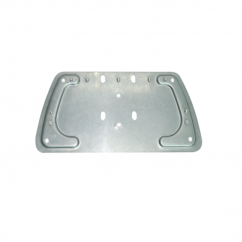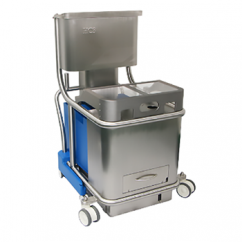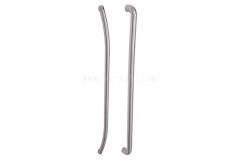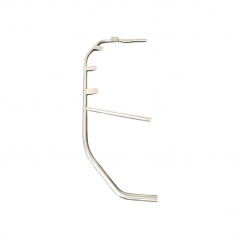Metro vehicles are the means of transport used by metro to transport passengers, which belong to the category of modern urban rapid rail transit. So how much do you know about the subway? The following is a summary of the subway theoretical knowledge compiled by the learner, which is provided for your reference and understanding. I hope you like it!

1、 Theoretical knowledge of metro - vehicle introduction
From the structure: the train adopts the form of decentralized power layout. Various non power vehicles and power vehicles (or semi power vehicles) are combined into a relatively fixed formation as required, and control consoles are set at both ends. Due to the limitation of tunnel gauge, vehicle gauge and equipment gauge, the design requirements of vehicle and its various on-board equipment are quite compact. Modularization shall be adopted as far as possible while facilitating maintenance.
In terms of structure, the car body is developing towards lightweight, mainly adopting large section hollow extruded aluminum profile modular car body structure design, and adopting integral bearing structure; The suspension system has a good damping system; Electric (regenerative braking and resistance braking) and air hybrid braking are adopted; Tight fitting coupler is used for fully automatic connection of mechanical, electrical and gas circuits for vehicle connection; Closed full gangway is adopted between vehicles, with large throughput.
From the aspect of application performance: because the service object of the subway is the urban high-density, large passenger flow crowd, and it needs to compete with the public transport system and cars, it has high requirements for its safety, punctuality and speed. Meanwhile, appropriate space, quiet environment and air conditioning shall be provided for passengers to make them feel comfortable and convenient.
In terms of operation mode, ATO shall be applied. In the main traction drive, the world's advanced frequency and voltage regulation AC drive is adopted. In the auxiliary system, advanced IG-BT technology is adopted.
The vehicle is the most critical and complex equipment in the subway system. It is a multidisciplinary and comprehensive product, involving machinery, electrical, control, materials and other fields. In a word, the vehicle is organically combined through various relatively independent subsystems to jointly realize the safe, reliable and high-quality operation of the train.
2、 Theoretical knowledge of subway - mechanical part
1. Car body
Generally, the car body adopts modular design. It includes self supporting frame, cab and middle end connected by bolts. The car body frame and the middle end are composed of large aluminum alloy profiles and plates, while the cab is composed of profile steel. The welded profiles are connected with the middle end and cab end through mechanical fastening devices. The cab and the middle end are covered by large glass fiber reinforced plastic covers. Absorb energy through the crushing pipe in the coupler system. In case of an accident, the anti climbing device at the front of the vehicle can disperse the collision force.
The trains are connected together through gangways, which are designed with folding sheds and gangways on couplers. The train surface shall be sprayed according to the characteristics of the city.
2. Door
Different doors shall be selected according to different vehicle operating environments. Take Guangzhou Metro Line 2 as an example. It is driven by a bidirectional motor, and adopts a belt drive and a screw rod device as the driving mechanism. The EDCU (electronic door control unit) controls the opening and closing and locking of the door. The control button is operated in the cab, and the EDCU controls the motor to rotate to realize the opening and closing of the door, and there is an obstacle geophysical detection reopening. The travel switch gives the status signal of the door, and the fault signal is transmitted by EDCU to VTCU (vehicle and train control unit) through the coded hard wire.
In terms of safety and reliability, mobile doors are generally applicable to trains with speed lower than 100km/h. Especially the external hanging door, because the external hanging door belongs to the external hanging structure, the lower part is suspended without support. When the train is running in the tunnel, with the increase of speed, its air blockage ratio increases greatly, and the hanging door of the external crane generates greater pressure. If the structure and strength of the door are not improved with the increase of speed, the door will produce instability factors such as shaking, which will affect the safety and reliability of the door.
Because the structure of the moving door determines that a certain clearance must be guaranteed between the door and the car body, the sealing of the moving door is poor. When the train reaches a certain running speed (more than 100km/h), there will be blowby in the compartment, which will bring discomfort to passengers; When the external pressure of the vehicle entering and exiting the tunnel changes, the comfort of the vehicle decreases with the change of the internal pressure. Due to the poor sealing of the moving door, the noise generated by the running parts of the vehicle can easily enter the vehicle; At the same time, because the moving door is concave or convex to the car body, the train will cause eddy current in the air nearby during driving, and the air resistance is large, which also limits the use speed of the moving door.
As the sliding plug door keeps a better streamline of the train in the same plane with the car body, it has the characteristics of good sealing and small air resistance. However, the structure of sliding plug door is more complex than that of mobile door, and its cost is higher.
Although the types of doors are different, their functions are largely the same and their performance parameters are similar.
For safety, the escape device is located in the middle of the front wall, including a large hinged window at the top and a ladder between two driver's desks. Normally, the ladder is folded and hidden. When the train cannot reach the next station, the escape device is used to evacuate passengers.
3. Coupler and buffer device
The coupler buffer device is composed of coupler, buffer and other components, which is installed on the traction beam of the underframe and is a safety component of the vehicle. Its function is:
(1) Coupling the vehicles to form a group of trains;
(2) Transmit longitudinal traction and impact;
(3) Mitigate the dynamic action between vehicles;
(4) Realize the connection of circuit and gas circuit.
There are three types of coupler buffer devices: automatic coupler, semi-automatic coupler and semi permanent drawbar. The three couplers are equipped with recoverable energy absorption function and rubber buffer. The automatic coupler and semi permanent drawbar are also equipped with overload protection device, and the irrecoverable crushable deformation tube. Its structure adopts advanced close fitting coupler, which is closely connected by mutual insertion of convex cone and concave cone on coupler heads of adjacent vehicles. Its advantages are: saving manpower, ensuring safety and convenience. Disadvantages: complex structure and low strength. Therefore, it is applicable to light rail vehicles such as subway and light rail.
4. Bogie
The bogie is a supporting running device that supports the car body and bears the running of the vehicle along the track. In order to facilitate curve negotiation, a center plate or rotating shaft is set between the car body and the bogie, and the bogie can rotate around a center shaft relative to the car body. In order to improve the running quality of the vehicle and meet the running requirements, spring devices and braking devices are set on the bogie. For motor car, the bogie is also equipped with traction motor and reducer to drive the vehicle. The bogie is mainly composed of the following parts: wheel set axle box device, elastic suspension device, framework, braking device, traction motor and gear variable speed transmission device, and bogie supporting body device. In addition, ATC communication antenna is also installed on the trailer bogie.
When the vehicle is running on the track, complex vibration and impact often occur due to the irregularity of the line, rail gap, turnout, rail surface defects and wear, as well as wheel tread slope, scratches, wheel axle eccentricity and other reasons. In order to improve the running stability, spring damping devices must be set. Air springs have significant advantages in improving the dynamic performance and running quality of vehicles, and are widely used in metro and light rail. In order to improve the vibration performance of vehicles, hydraulic shock absorbers are mostly used in subways.
As the subway undertakes the task of transporting passengers and operates in underground tunnels or overhead lines, the bogie is required to have low noise and good vibration reduction performance, and be able to adapt to changes in heavy load and no-load. Generally, air spring and rubber spring are widely used as elastic suspension components. Spring damping devices include primary suspension herringbone multilayer rubber spring or conical spring, secondary suspension air spring, vertical hydraulic damper, horizontal hydraulic damper, anti rolling torsion bar and horizontal rubber buffer.
Traction transmission device plays a very important role in electric passenger cars, and is the core device to drive train operation. It includes a traction motor, gear coupling and gear. Its function is to transmit the power output by the traction motor to the wheel set. The driving mechanism of the vehicle is a kind of deceleration device, which is used to make the traction motor with high speed and small torque drive the moving shaft with large resistance torque. The requirements for the driving mechanism are that the power of the traction motor can be brought into play; The motor armature shaft shall be concentric with the coupling to reduce the action force of uneven line to gear. Briefly describe the transmission line with block diagram:
The traction motor adopts three-phase AC induction motor. Because of this electric drive mode, the traction performance is good, the operation is reliable, and the vehicle has good traction braking performance.
5. Braking device
According to mature metro experience, brake shoe braking is used for friction braking. In order to improve the friction performance and increase the resistance of metro vehicles, metro vehicles are used to transport passengers, which belongs to the scope of modern urban rapid rail transit. So how much do you know about the subway? The following is a summary of the subway theoretical knowledge compiled by the learner, which is provided for your reference and understanding. I hope you like it!
1、 Theoretical knowledge of metro - vehicle introduction
From the structure: the train adopts the form of decentralized power layout. Various non power vehicles and power vehicles (or semi power vehicles) are combined into a relatively fixed formation as required, and control consoles are set at both ends. Due to the limitation of tunnel gauge, vehicle gauge and equipment gauge, the design requirements of vehicle and its various on-board equipment are quite compact. Modularization shall be adopted as far as possible while facilitating maintenance.
In terms of structure, the car body is developing towards lightweight, mainly adopting large section hollow extruded aluminum profile modular car body structure design, and adopting integral bearing structure; The suspension system has a good damping system; Electric (regenerative braking and resistance braking) and air hybrid braking are adopted; Tight fitting coupler is used for fully automatic connection of mechanical, electrical and gas circuits for vehicle connection; Closed full gangway is adopted between vehicles, with large throughput.
From the aspect of application performance: because the service object of the subway is the urban high-density, large passenger flow crowd, and it needs to compete with the public transport system and cars, it has high requirements for its safety, punctuality and speed. Meanwhile, appropriate space, quiet environment and air conditioning shall be provided for passengers to make them feel comfortable and convenient.
In terms of operation mode, ATO shall be applied. In the main traction drive, the world's advanced frequency and voltage regulation AC drive is adopted. In the auxiliary system, advanced IG-BT technology is adopted.
The vehicle is the most critical and complex equipment in the subway system. It is a multidisciplinary and comprehensive product, involving machinery, electrical, control, materials and other fields. In a word, the vehicle is organically combined through various relatively independent subsystems to jointly realize the safe, reliable and high-quality operation of the train.
2、 Theoretical knowledge of subway - mechanical part
1. Car body
Generally, the car body adopts modular design. It includes self supporting frame, cab and middle end connected by bolts. The car body frame and the middle end are composed of large aluminum alloy profiles and plates, while the cab is composed of profile steel. The welded profiles are connected with the middle end and cab end through mechanical fastening devices. The cab and the middle end are covered by large glass fiber reinforced plastic covers. Absorb energy through the crushing pipe in the coupler system. In case of an accident, the anti climbing device at the front of the vehicle can disperse the collision force.
The trains are connected together through gangways, which are designed with folding sheds and gangways on couplers. The train surface shall be sprayed according to the characteristics of the city.
2. Door
Different doors shall be selected according to different vehicle operating environments. Take Guangzhou Metro Line 2 as an example. It is driven by a bidirectional motor, and adopts a belt drive and a screw rod device as the driving mechanism. The EDCU (electronic door control unit) controls the opening and closing and locking of the door. The control button is operated in the cab, and the EDCU controls the motor to rotate to realize the opening and closing of the door, and there is an obstacle geophysical detection reopening. The travel switch gives the status signal of the door, and the fault signal is transmitted by EDCU to VTCU (vehicle and train control unit) through the coded hard wire.
In terms of safety and reliability, mobile doors are generally applicable to trains with speed lower than 100km/h. Especially the external hanging door, because the external hanging door belongs to the external hanging structure, the lower part is suspended without support. When the train is running in the tunnel, with the increase of speed, its air blockage ratio increases greatly, and the hanging door of the external crane generates greater pressure. If the structure and strength of the door are not improved with the increase of speed, the door will produce instability factors such as shaking, which will affect the safety and reliability of the door.
Because the structure of the moving door determines that a certain clearance must be guaranteed between the door and the car body, the sealing of the moving door is poor. When the train reaches a certain running speed (more than 100km/h), there will be blowby in the compartment, which will bring discomfort to passengers; When the external pressure of the vehicle entering and exiting the tunnel changes, the comfort of the vehicle decreases with the change of the internal pressure. Due to the poor sealing of the moving door, the noise generated by the running parts of the vehicle can easily enter the vehicle; At the same time, because the moving door is concave or convex to the car body, the train will cause eddy current in the air nearby during driving, and the air resistance is large, which also limits the use speed of the moving door.
As the sliding plug door keeps a better streamline of the train in the same plane with the car body, it has the characteristics of good sealing and small air resistance. However, the structure of sliding plug door is more complex than that of mobile door, and its cost is higher.
Although the types of doors are different, their functions are largely the same and their performance parameters are similar.
For safety, the escape device is located in the middle of the front wall, including a large hinged window at the top and a ladder between two driver's desks. Normally, the ladder is folded and hidden. When the train cannot reach the next station, the escape device is used to evacuate passengers.
3. Coupler and buffer device
The coupler buffer device is composed of coupler, buffer and other components, which is installed on the traction beam of the underframe and is a safety component of the vehicle. Its function is:
(1) Coupling the vehicles to form a group of trains;
(2) Transmit longitudinal traction and impact;
(3) Mitigate the dynamic action between vehicles;
(4) Realize the connection of circuit and gas circuit.
There are three types of coupler buffer devices: automatic coupler, semi-automatic coupler and semi permanent drawbar. The three couplers are equipped with recoverable energy absorption function and rubber buffer. The automatic coupler and semi permanent drawbar are also equipped with overload protection device, and the irrecoverable crushable deformation tube. Its structure adopts advanced close fitting coupler, which is closely connected by mutual insertion of convex cone and concave cone on coupler heads of adjacent vehicles. Its advantages are: saving manpower, ensuring safety and convenience. Disadvantages: complex structure and low strength. Therefore, it is applicable to light rail vehicles such as subway and light rail.
4. Bogie
The bogie is a supporting running device that supports the car body and bears the running of the vehicle along the track. In order to facilitate curve negotiation, a center plate or rotating shaft is set between the car body and the bogie, and the bogie can rotate around a center shaft relative to the car body. In order to improve the running quality of the vehicle and meet the running requirements, spring devices and braking devices are set on the bogie. For motor car, the bogie is also equipped with traction motor and reducer to drive the vehicle. The bogie is mainly composed of the following parts: wheel set axle box device, elastic suspension device, framework, braking device, traction motor and gear variable speed transmission device, and bogie supporting body device. In addition, ATC communication antenna is also installed on the trailer bogie.
When the vehicle is running on the track, due to the irregularity of the line, rail gap, turnout, rail surface defects and wear, as well as the inclination of the wheel tread, scratches, wheel axle eccentricity and other reasons








 What help do you need?
What help do you need?